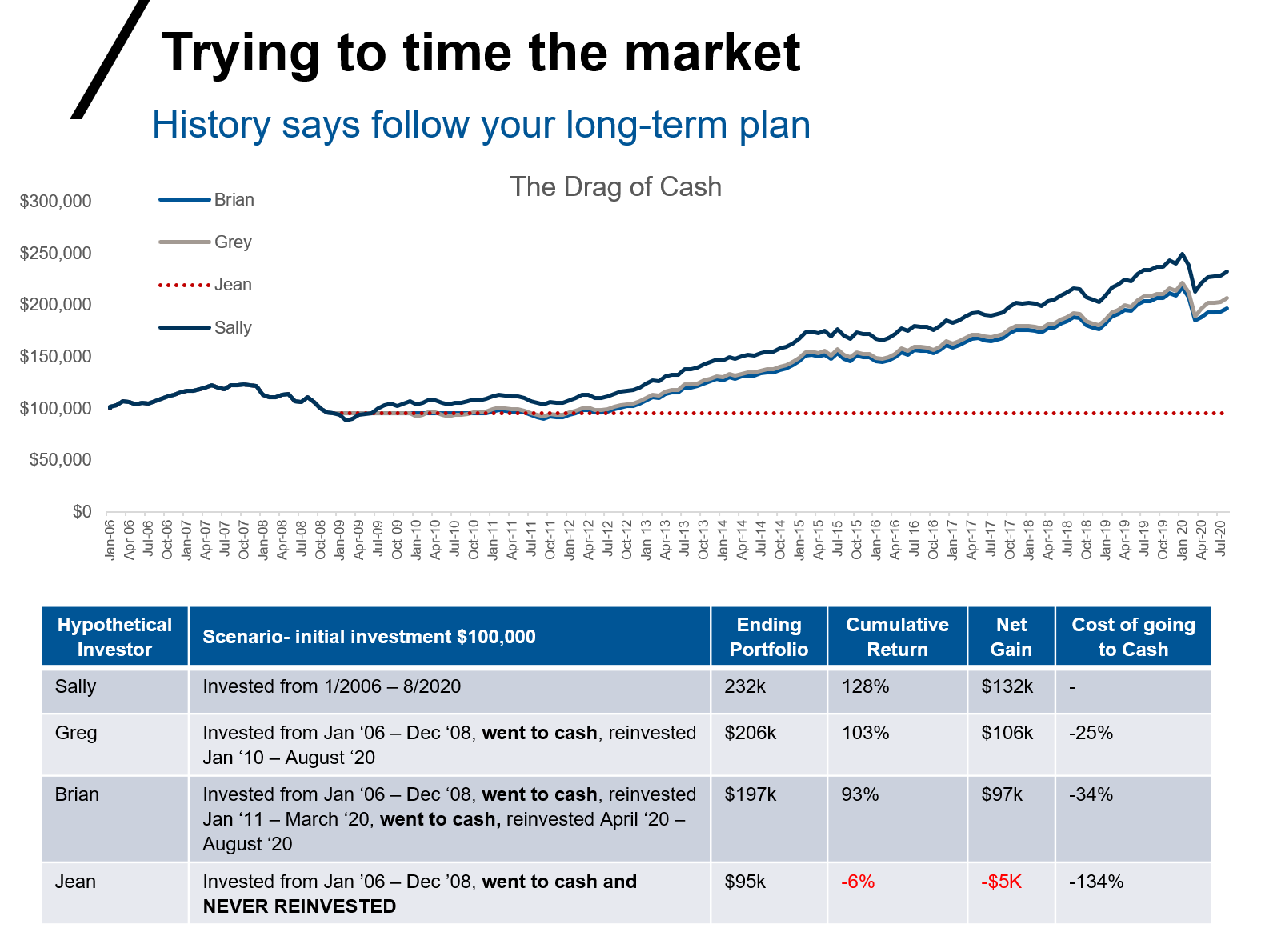The risks of fleeing to cash in times of crisis
When it comes to investing through a crisis, are investors better off in the market or in cash? A look at 4 scenarios.
As markets unraveled early 2020, there were few places for investors to hide. As the coronavirus spread at an alarming rate across the globe, equity markets sold off indiscriminately, causing many panicked investors to sell riskier assets in exchange for cash.
Flight to cash
Parting ways with equity investments at or near a market bottom isn’t a new trend. Many investors have approached equities with caution since the Global Financial Crisis (GFC) in 2008-09.
During times of crisis, many investors who’ve worked their whole lives saving for retirement, start thinking about what happened during past recessions, such as the Global Financial Crisis (GFC). Memories of these prior events, coupled with the barrage of frightening headlines from media outlets, can make it tough to maintain a planned asset mix and stay invested amid a market correction
But are investors well-served by abandoning their long-term allocations to move to the safety—but limited return potential—of cash? It’s true that with the turmoil of the COVID-19 sell-off still in its infant stages, the future is yet to be fully seen. However, it’s fair to say that moving to cash at this year’s market bottom and forgoing return from equities is likely to have been a costly mistake for many investors.
The story of moving to cash
For perspective, let’s consider a longer-term scenario of four hypothetical investors and their slightly different paths through two major crises. Each investor starts with $100,000 in a balanced portfolio on January 1, 2006.
- Sally (stays invested through thick and thin)
- At the end of this 14+ year period, Sally’s portfolio is worth over $230k. Despite going through both the GFC and the COVID-19 crisis, Sally’s portfolio had a cumulative return of 128%.
- Greg (learns from the GFC and stays invested during the COVID-19 crisis)
- Invests the same way as Sally, although Greg moves to cash at the end of December 2008 where his portfolio is worth $95k at that time. Even though Greg lost principle, he managed to bail before the bottom of the GFC which occurred on March 9, 2009.
- On Jan. 1, 2010, when the GFC rebound was seven months old, Greg comfortably re-enters and moves his cash back into a balanced portfolio.
- By the end of June 2020, Greg’s portfolio is now worth roughly $206k or roughly $25k less than Sally’s.
- Brian (tries timing the market … and stumbles)
- Has a similar strategy to Greg, although he waits an extra year before re-entering the market in early 2011. Then, after being invested for over nine years, he moves back into cash at the end of March 2020. On April 13, 2020, Brian has some serious fear of missing out after he sees equity markets show signs of bouncing back and decides to reenter his balanced portfolio.
- By the end of June 2020, Brian’s account would be worth just under $197k, over $35k less than Sally’s account and almost $10k less then Greg’s.
- Jean (stays in cash)
- This scenario could be considered the worst case, where Jean used the same investment scheme as Greg. However, after leaving the market in 2009, she was never comfortable resuming her previous investment strategy. Jean’s portfolio has a cumulative loss of -6.4% and is worth $95k, or a loss of approximately $4.6k of her starting balance, not mention missing out on the upside growth the others benefited from.

Source: Morningstar Rebalance monthly. Cost of going to cash : Cumulative return of Greg, Brian, or Jean minus cumulative return of Sally. Balanced Portfolio: 30% MSCI World NR AUD, 30% S&P/ ASX 200, 12.5% BBgBarc Global Agg TR Hdg AUD, 12.5% BBg AusBond Bank 0+Y AUD, 5% FTSE EPRA NAREIT Dev TR AUD, 5%S&P Global Infrastructure NR AUD, 5% Cash. For illustrative purposes only.
Timing the market
We all know the market goes up and down each day, although wild swings can make even the most collected investor second-guess their strategy. Sometimes swings are much more volatile than usual - meaning that checking your investment account daily can create unnecessary stress and perhaps worse, major investment setbacks in trying to time the market.
The bottom line
Another way to look at this is to consider that your home is an investment—even though it’s often not viewed as one in the same manner that your retirement is. Like the equity market, the housing market also sees swings in value. But do you check the value of your home each and every day? If you’re not planning to sell soon, you likely don’t.
We believe the same logic should hold true for your other investments as well. If you have a long-term time horizon and an investment plan in place, but find yourself tempted to stray from that plan amid the COVID-19 crisis, it may make sense to discuss further with a financial professional—in order to fully understand the impacts of trying to time the market.
Ultimately, staying invested may pay off, even in times of crisis
Got clients riding the wave of emotions in the market? Then explore our surfable chart: The cycle of investor emotions.